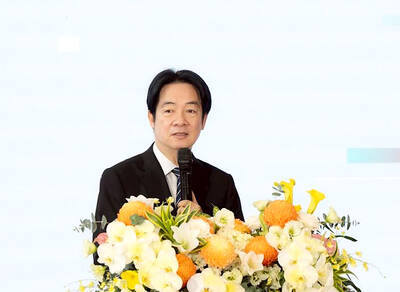US military officials and analysts have for years warned of possible armed attacks or blockades by China on Taiwan, but a report released on Friday has raised a red flag about possible nonmilitary tactics that could be used effectively against Taiwan.
Beijing could wage an economic and cyberwar to force a surrender from Taiwan without the direct use of military power, the Foundation for Defense of Democracies (FDD), a Washington-based research institute, said in the report.
Such a likely, but overlooked, scenario poses a challenge for the US, Taiwan’s biggest ally, it said, suggesting that Washington make preparations for how best to respond.

Photo: Reuters
FDD researchers teamed up with banking and finance experts in Taiwan over two days earlier this year to simulate likely nonmilitary moves by Beijing, such as disinformation campaigns and cyberattacks on infrastructure.
The exercise was the first of its kind and sought to fill an analytical gap, the think tank said.
“Modern globalization has created more economic connections that China can exploit to achieve coercive aims,” the report said. “Technological innovation created even more digital connections, offering more possibilities for coercion, including through the targeting of critical infrastructure.”
Beijing has vowed to take Taiwan, by force if necessary, although Chinese President Xi Jinping (習近平) has promised to make “utmost efforts” to do so peacefully.
Tensions have flared in the Taiwan Strait since 2016 when Beijing began to increase diplomatic and military pressure on the nation, prompting the US to step up its support.
Washington, which is obligated under US law to provide Taipei with sufficient military hardware for its defense, has said that it is in the US interest to keep peace in the Strait and to stand with democracies such as Taiwan to maintain the rules-based world order.
Beijing has demanded the US stay out of Taiwan, saying that it is a purely domestic affair.
US President Joe Biden has indicated he would send troops to defend Taiwan in case of an armed attack from China, but the US government has yet to formulate a plan to respond to nonmilitary tactics, giving Beijing flexibility in working to undermine Taiwan without triggering an outright response from Washington that a military invasion would, the FDD researchers said.
Taiwan’s foreign and defense ministries had no immediate comment on the report.
With an estimated 1 million Taiwanese living and working in China, economic ties have grown ever closer, which has made the possibility of economic coercion, boycotts and military blockades an even bigger threat.
In the simulation exercises, the experts from the US and Taiwan studied possible moves by Beijing such as conducting psychological wars to erode public trust, banning imports of Taiwanese products or raising tariffs on them, short-selling Taiwanese stocks, freezing bank transfers across the Strait, cutting fiber optic cables, and targeting energy imports and storage.
Recommendations include that Taiwan diversify its energy imports, relocate businesses away from China, develop new markets, and build alliances and partnerships. The report suggested that the US develop a playbook of options to counter China and improve coordination with allies.
The Taiwan Academy of Banking and Finance, which worked with the FDD on the simulation exercises, has said that Taiwan must bolster its financial resilience.
“China could destabilize Taiwan’s financial system to incite social unrest as a precursor to invasion,” the report said.
Russell Hsiao (蕭良其), executive director of the Washington-based Global Taiwan Institute, said Beijing has already been ramping up nonmilitary measures against Taiwan and that such efforts are expected to intensify in the coming months and years.
“It behooves the United States and Taiwan to work with allies and like-minded partners to strengthen our collective resilience to China’s weaponization of economic interdependence,” he said.

MISINFORMATION: The generated content tends to adopt China’s official stance, such as ‘Taiwan is currently governed by the Chinese central government,’ the NSB said Five China-developed artificial intelligence (AI) language models exhibit cybersecurity risks and content biases, an inspection conducted by the National Security Bureau (NSB) showed. The five AI tools are: DeepSeek, Doubao (豆包), Yiyan (文心一言), Tongyi (通義千問) and Yuanbao (騰訊元寶), the bureau said, advising people to remain vigilant to protect personal data privacy and corporate business secrets. The NSB said it, in accordance with the National Intelligence Services Act (國家情報工作法), has reviewed international cybersecurity reports and intelligence, and coordinated with the Ministry of Justice Investigation Bureau and the National Police Agency’s Criminal Investigation Bureau to conduct an inspection of China-made AI language

BOOST IN CONFIDENCE: The sale sends a clear message of support for Taiwan and dispels rumors that US President Donald Trump ‘sold out’ the nation, an expert said The US government on Thursday announced a possible sale to Taiwan of fighter jet parts, which was estimated to cost about US$330 million, in a move that an expert said “sends a clear message of support for Taiwan” amid fears that Washington might be wavering in its attitude toward Taipei. It was the first announcement of an arms sale to Taiwan since US President Donald Trump returned to the White House earlier this year. The proposed package includes non-standard components, spare and repair parts, consumables and accessories, as well repair and return support for the F-16, C-130 and Indigenous Defense Fighter aircraft,

CHECKING BOUNDARIES: China wants to disrupt solidarity among democracies and test their red lines, but it is instead pushing nations to become more united, an expert said The US Department of State on Friday expressed deep concern over a Chinese public security agency’s investigation into Legislator Puma Shen (沈伯洋) for “secession.” “China’s actions threaten free speech and erode norms that have underpinned the cross-strait ‘status quo’ for decades,” a US Department of State spokesperson said. The Chongqing Municipal Public Security Bureau late last month listed Shen as “wanted” and launched an investigation into alleged “secession-related” criminal activities, including his founding of the Kuma Academy, a civil defense organization that prepares people for an invasion by China. The spokesperson said that the US was “deeply concerned” about the bureau investigating Shen

‘TROUBLEMAKER’: Most countries believe that it is China — rather than Taiwan — that is undermining regional peace and stability with its coercive tactics, the president said China should restrain itself and refrain from being a troublemaker that sabotages peace and stability in the Indo-Pacific region, President William Lai (賴清德) said yesterday. Lai made the remarks after China Coast Guard vessels sailed into disputed waters off the Senkaku Islands — known as the Diaoyutai Islands (釣魚台) in Taiwan — following a remark Japanese Prime Minister Sanae Takaichi made regarding Taiwan. Takaichi during a parliamentary session on Nov. 7 said that a “Taiwan contingency” involving a Chinese naval blockade could qualify as a “survival-threatening situation” for Japan, and trigger Tokyo’s deployment of its military for defense. Asked about the escalating tensions